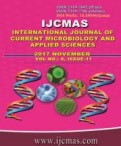


 National Academy of Agricultural Sciences (NAAS)
National Academy of Agricultural Sciences (NAAS)

|
PRINT ISSN : 2319-7692
Online ISSN : 2319-7706 Issues : 12 per year Publisher : Excellent Publishers Email : editorijcmas@gmail.com / submit@ijcmas.com Editor-in-chief: Dr.M.Prakash Index Copernicus ICV 2018: 95.39 NAAS RATING 2020: 5.38 |
An alarming fall in groundwater table in Northwest India demands a major shift from traditional method of rice cultivation to direct seeding of rice. Dry-seeded rice has emerged as a viable option to save water, labour, energy and time. Proper tillage and irrigation practices are needed to improve water productivity in dry-seeded rice through reduction in emergence of weeds and reduce ground water depletion and pesticide use. A field experiment was conducted at the research farm of the Department of Soil Science, Punjab Agricultural University, Ludhiana, during Kharif season to study tillage and irrigation regimes effects on water productivity of dry-seeded rice. The treatments included combination of two tillage regimes (deep tillage and conventional tillage) and irrigation regimes (Irrigation based on IW/CPE ratio of 2.4 (I2.4) and 1.2 (I1.2). Deep tillage incorporates weeds into deeper layers and reduces pesticide use, induced root proliferation, increased uptake of water. DT also had higher grain yield (5.4 t ha-1) than CT (4.4 t ha-1). Among the tillage regimes, DT I1.2 was observed to have higher water use efficiency. Increasing irrigation frequency reduced irrigation-based WP (WPI). DT enhanced WPI from 4.8 to 6.5 kg ha-1 mm-1 in I1.2 regime, and from 4.4 to 5.1 kg ha-1 mm-1 in I2.4 regime. Root mass below 0.10 m soil depth in CTI1.2, CTI2.4, DTI1.2 and DTI2.4 regimes was 4.2, 8.8, 9.7 and 9.4 g m-2 at panicle emergence. Among irrigation and tillage regimes weed infestation lesser in DTI1.2 as compare to other treatments due to less availability of water in surface layers.
 |
 |
 |
 |
 |